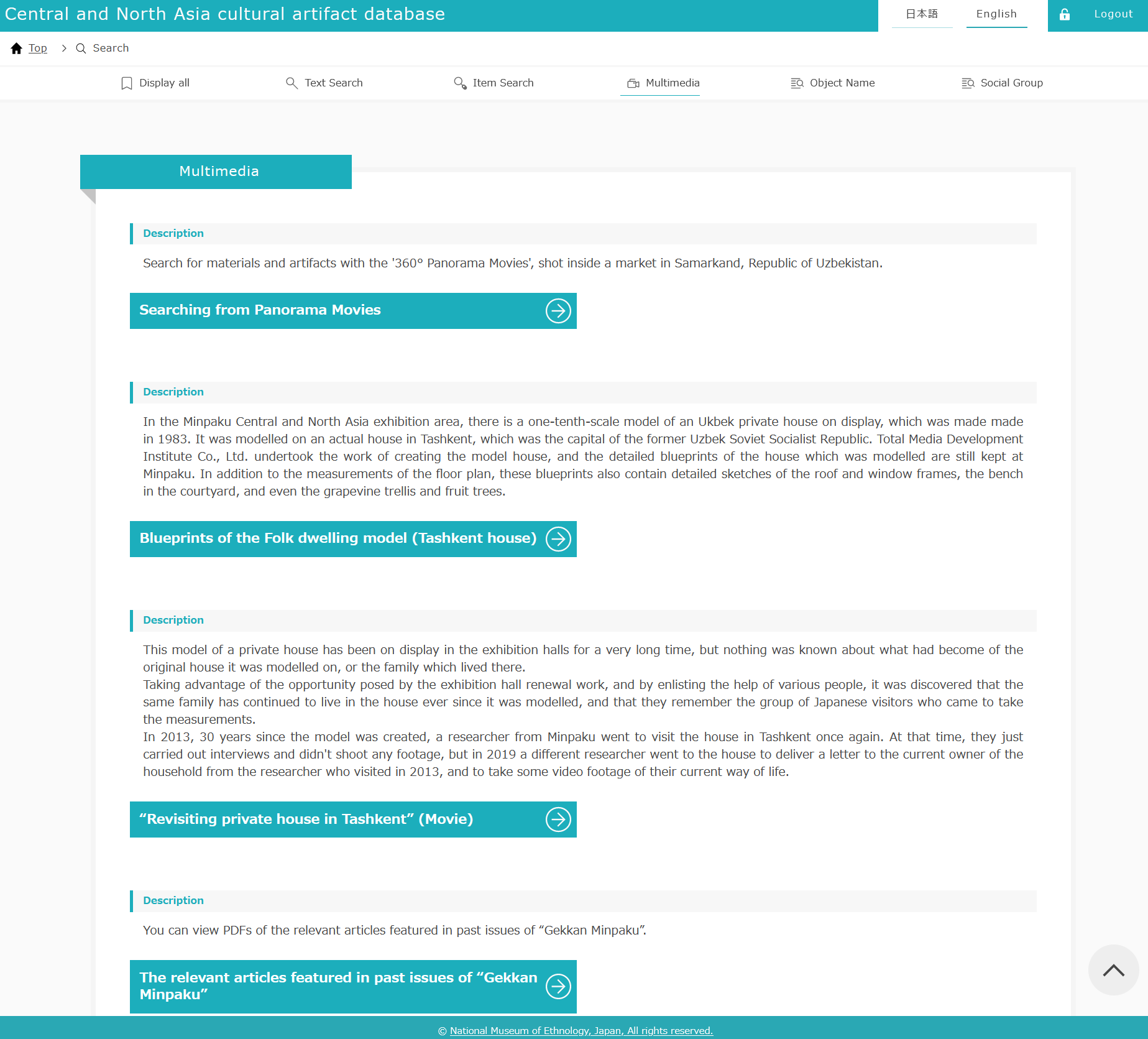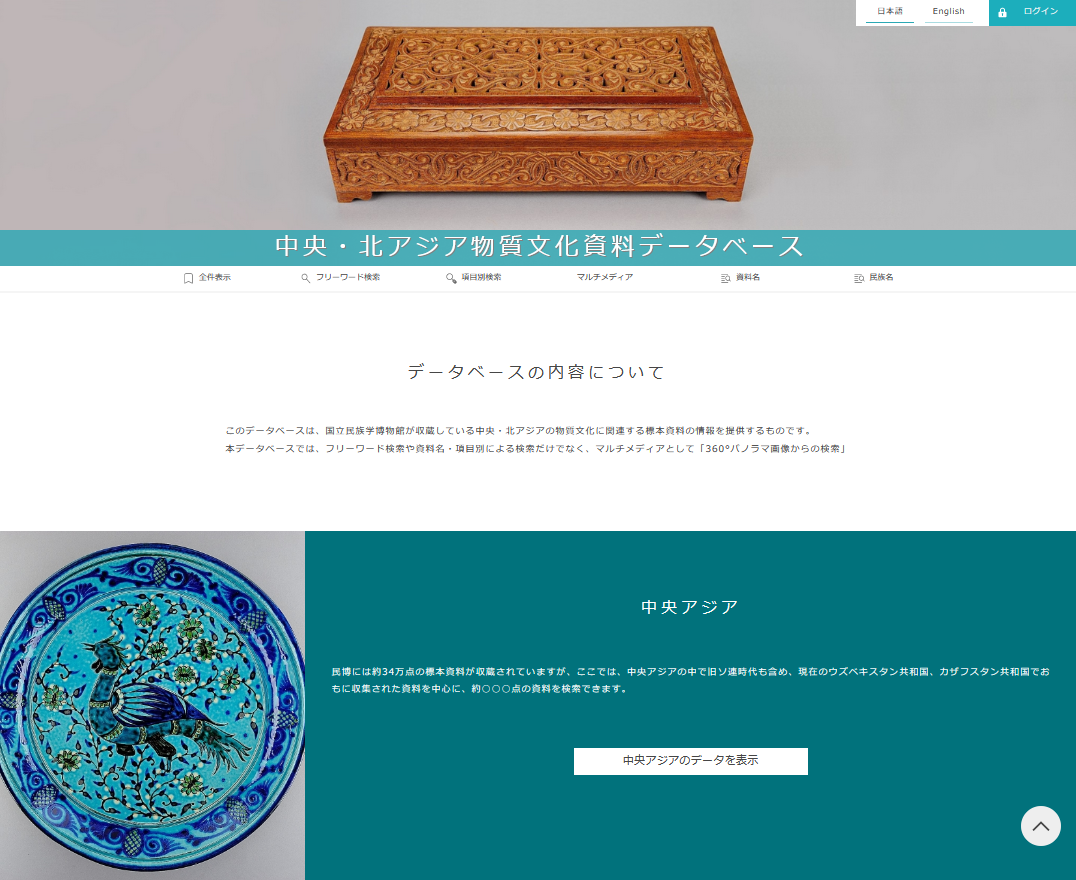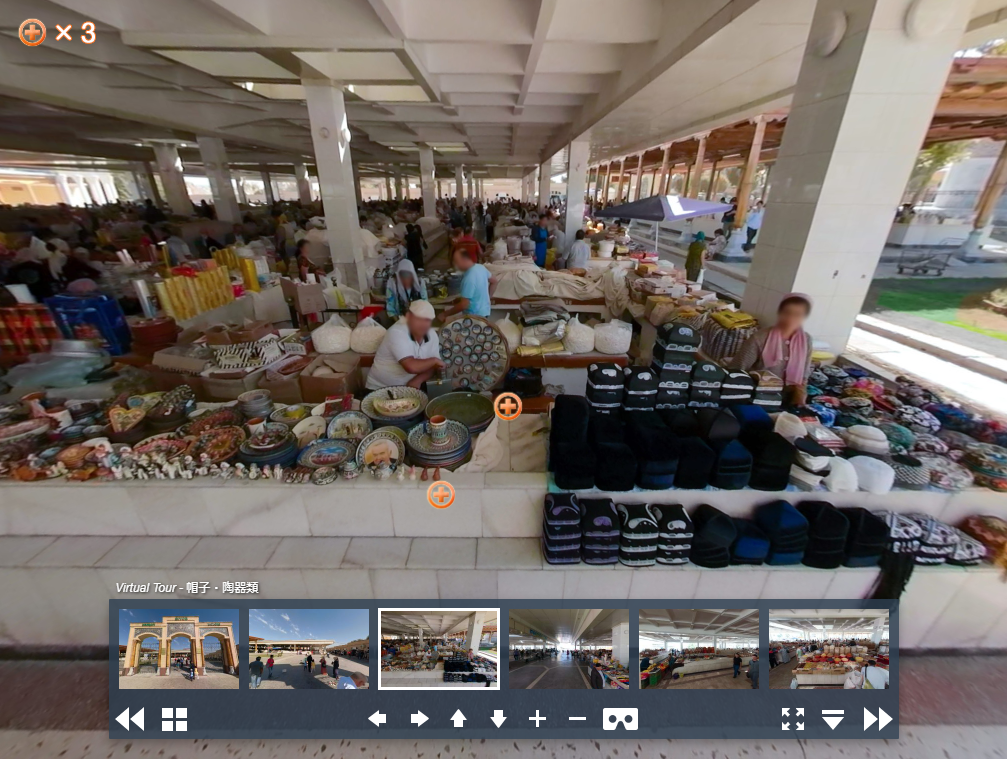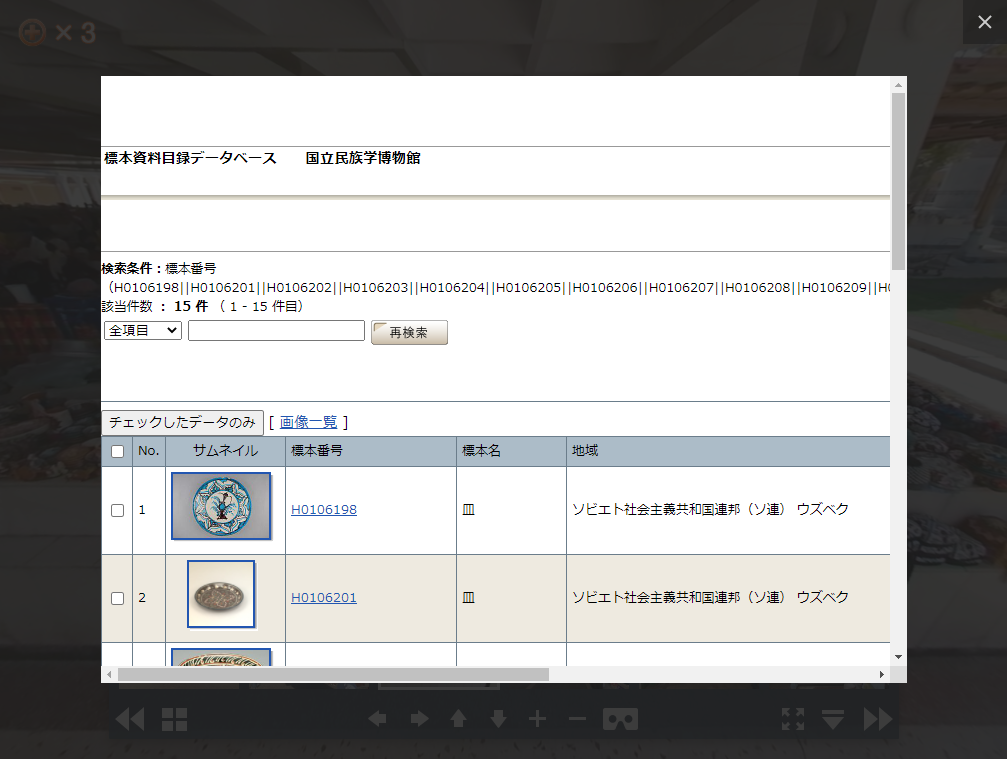Material Culture in Central and North Asia: Ethno-Cultural Objects at the National Museum of Ethnology
Research period : April 2018‒ March 2022 / Project for Database Establishment (project period: max. 4 years)
Coordinator TERAMURA Hirofumi
Outline
Objectives
Minpaku houses a collection of many ethno-cultural assets (artifacts and audio-visual materials) acquired from locations in Central and North Asia. In June 2016, Minpaku opened a new exhibit on Central and North Asia utilizing a selection of these assets. In the process of developing this new exhibit, studies were performed on North and Central Asian artifacts and a significant volume of new research data was accumulated. In its current form, the exhibit now open to the public represents only a small fraction of that information. This project will comprise research in cooperation with local communities and foreign research institutions on material cultures extending over a vast area from Russia’s Chukotka Peninsula, Kamchatka Peninsula, and Sakhalin Islands in the east through the Russian Far East, Siberia, and Mongolia to Central Asia in the west, with a focus on the material artifacts in the Minpaku collection. The findings and accomplishments of that research will be put into a database format and disseminated by the Info-Forum Museum.
Description
For this project, the vast area outlined above will be divided into the three regions of Russia, Mongolia, and Central Asia, with the following surveys and studies to be performed. A database of information on cultural assets in Central and North Asia will then be developed based on the findings of these surveys and studies.
(1) Project leaders will draft a four-year comprehensive plan for this project. Next, we will select foreign and domestic research institutions, museums, and local communities with which we will need cooperative arrangements to implement joint research, conclude cooperative agreements as necessary, and establish frameworks for networking and research.
(2) Samples of artifacts from these regions will be selected from the existing Minpaku artifact database and data elements will be formulated for the database to be created through this project. We will verify and correct information on ethno-cultural assets relevant to the selected materials, build a basic database in Japanese and English, and augment it with accurate information in local languages.
(3) We will implement local surveys and joint research, workshops and international symposia on material culture in collaboration with foreign and domestic research institutions and local communities, and utilize their outcomes to enhance existing information on cultural assets.
(4) We will verify the content of information on cultural assets to be placed in the database, sort and classify the information for publication, and complete the development of database content.
(5) Working in collaboration with the system development expert subcommittee and editorial team, we will develop a system for the dissemination of enhanced information on cultural assets and publish database information with that system.
(6) We will host local workshops on database use to facilitate database utilization by local communities. In addition, working in collaboration with other research institutions that are engaged in the dissemination of comparable museum information, we will host international symposia that discuss or utilize the databases containing such information.
(7) We will publish in research papers, proceedings, or essays the outcomes of local surveys, joint research, workshops, international symposia, and other activities that are implemented in the process of building our database.
Expected results
Note: Results also reveal what kind of database it would be.
The information on cultural assets on public display at the Minpaku exhibit on Central and North Asia will form the core of this database. Working with that core data, we will enhance the information on material artifacts from these regions that are in the Minpaku collection and disseminate that information worldwide over the internet.
The exhibit on Central and North Asia provides a general, cross-cultural overview of several features common to Central Asia, Mongolia, Siberia, and the Far North. These include adaptation to the natural environment and forms of subsistence, daily life and religious beliefs, and experiences with socialism, while also taking their differences into account. Drawing perspective from these themes and utilizing the materials in the exhibit as a foundation, we will be able to deepen our information on cultural assets related to Central and North Asia and facilitate the advancement of future research in these regions by adding to the material artifacts stored in the Minpaku repository, as necessary.
This database may be utilized not only for university education and research of relevance to the field of cultural anthropology, the study of material culture, and area studies with a focus on Central and North Asia, but also to aid the preservation and restoration of the cultures of regional societies.
Annual Report
Outcomes from 2021
1. The state of the implementation of this year’s research
The vast area of this project is divided into the three regions of Russia, Mongolia, and Central Asia, and with the information on cultural assets displayed in Minpaku’s Central and North Asia exhibit at its core, the project aims to enhance information relating to material artifacts of this region housed at Minpaku and to construct a database of Central and North Asian cultural assets based on these results. This year was the final year of the project, and in particular, the following research was undertaken, focusing on the implementation of content for launch of the database.
1) For materials related to Siberia and the Far North (primarily Russia) for which data had not been fully organized, we selected artifacts to be recorded into the database and conducted entry of basic items in Japanese and English.
2) Materials related to Siberia and the Far North were added to the Central and North Asia Cultural Artifact Database (trial version) that was built last year utilizing the info-forum database template.
(Central Asia) artifacts number: 1,198, record number: 18 x 1,198=21,564
(Mongolia) artifacts number: 2,960, record number: 18 x 2,960=53,280
(Siberia/the Arctic) artifacts number: 879, record number: 18 x 879=15,882
3) To upgrade the Central and North Asia cultural objects information, we added the following multimedia content prepared last year to the database (see figure 1).
*Search from Panoramic Tour (linked with database)
*Schematic (blueprint) for “Model of Private House in Tashkent” (JPG images of drawings added)
*Revisiting a Private House in Tashkent (interview video program added)
*Gekkan Minpaku (Minpaku Monthly) articles (links to Central and North Asia related articles)
4) Focusing on the Uzbekistan artifacts, we met online with affiliated local institutions (in Uzbekistan) and collaborating researchers, and with the cooperation of researchers there were able to carry out checks of the English and Russian translations.
5) Regarding Kazakhstan materials, we introduced the database currently under construction to an international conference.
6) We conducted evaluation work at the copyright level for all records in the database in order to determine whether to use “high-definition images” or “thumbnail images” when launched to the public for the artifact images within the Central and North Asia Cultural Artifact Database.

Figure 1: “Multimedia” search screen in the Central and North Asia Cultural Artifact Database
2. Overview of the research results (achievements of the research objects)
As this is the final year of the project, we focused on implementing database construction for launch within the museum and for the general public based on the research plan. These results were detailed in the section “1. The state of the implementation of this year’s research.”
Furthermore, in the process of conducting online meetings with local partner institutions and research collaborators, we were able to contribute to the publishing of a booklet for the general public, give presentations at lectures, sectional meetings of academic conferences, and international conferences, and co-author an English paper, including matters related to local surveys conducted in the past.
●Toko Fujimoto 2021 “Japoniyadaghï qazaqi etnografiyalïq kollektsiya” (Kazakh ethnographic materials in Japan), Mezhdenarodnyi vebinar “Istoriya kazakhskoi gosudarstvennosti v artefaktakh i arkhivnykh dokumentakh” (international conference titled “History of Kazakh nationhood in artifacts and archives,” held online), October 8, 2021.
Other specific disclosing achievements will be described in the next section, “3. Records disclosing achievements.”
We are making final arrangements with the aim of launching the database within the museum by the end of March 2022, and to the public as early as possible after April of the following year.
3. Records disclosing achievements (publications, public symposia, sectional meetings of academic conferences, electronic media, etc.)
Records disclosing achievements (publications, public symposia, sectional meetings of academic conferences, electronic media, etc.)
●Hirofumi Teramura and Tomomi Murakami 2021 ” Investigation and conservation of the Kafir-kara site in Uzbekistan” Japan Consortium for International Cooperation in Cultural Heritage, East and Central Asia Subcommittee, 33rd (held online), May 14, 2021.
Outcomes from 2020
1. The state of the implementation of this year’s research
The vast area of this project is divided into the three regions of Russia, Mongolia, and Central Asia, and with the information on cultural assets displayed in Minpaku’s Central and North Asia exhibit at its core, the project aims to enhance information relating to material artifacts of this region housed at Minpaku and to construct a database of Central and North Asian cultural assets based on these results. In this third year of the four year project, due to the COVID-19 pandemic, we were unable to carry out the planned surveys and research overseas, but progressed the project focusing on those activities possible in Japan. In particular, the following research was undertaken.
1) The database’s basic category headings were confirmed. Focussing on the regions and ethnic groups where members of the project have carried out fieldwork and with the aim of achieving a cross-cultural overview, the database’s basic category headings were decided by using common keywords from the exhibit such as adaptation to the natural environment and livelihoods, everyday life and beliefs, experience of socialism and so on.
2) The basic database for North Asian cultural assets was constructed in English and Japanese and information in local languages was added.
3) Though only viewable to those in the project team, the provisional version of the ‘Central and North Asia cultural artifact database’ was constructed based on the info-forum database template [http://ifm.idc.minpaku.ac.jp/cnasia/].
Central Asia – artifact number: 1,198; number of records: 18 x 1,198=21,564
North Asia – artifact number: 2,960; number of records: 18 x 2,960=53,280

Figure 1: Landing page of ‘Central and North Asia cultural artifact database’ (Trial version)
4) Multimedia content was produced for the enrichment of information on the Central and North Asia cultural artifacts, including:
● Production and editing of interviews about the ‘Traditional Tashkent house – 1/10 scale model’
● Digitisation of the blueprints for the ‘Traditional Tashkent house – 1/10 scale model’
● Samarkand Bazaar panorama film editing and connectivity with the database
5) Focusing on the Uzbekistan artifacts, we met online with researchers from collaborating institutions in Uzbekistan and with the cooperation of researchers there were able to carry out checks of the English and Russian translations.
2. Overview of the research results (achievements of the research objects)
Based on this year’s research project plan, we were to collaborate with research institutions both domestically and overseas and carry out local surveys and collaborative research on Central and North Asian material cultures, also holding workshops. However, due to the COVID-19 pandemic we were unable to carry out these overseas surveys and research. We therefore brought forward work that could be carried out in Japan domestically, including the confirmation of basic categories, the addition of information in local languages, and the construction of the trial database. The relevant results have been indicated previously in point 3 of ‘4. The state of the implementation of this year’s research’.
Further, through the process of engaging with colleagues at related institutions and with collaborating researchers online, we presented a co-authored paper related to the local surveys carried out to date, which was published in the following journal.
Alisher BEGMATOV, Amriddin BERDIMURODOV, Gennadiy BOGOMOLOV, MURAKAMI Tomomi, TERAMURA Hirofumi, UNO Takao and USAMI Tomoyuki
(2020/08) ‘New Discoveries from Kafir-kala: Coins, Sealings, and Wooden Carvings’, ACTA ASIATICA (Bulletin of the Institute of Eastern Culture) (119): 1-20. Tokyo: Institute of Eastern Culture.
In terms of the production of the multimedia content, we edited and produced a 25 minute film related directly to an artifact in the Minpaku exhibit, ‘Traditional Tashkent house – 1/10 scale model’ (H0105532). In order to make it viewable via the info-forum database (possibly password protected), we will undertake to include it in the database in the next year of the project.
`In the previous year of the project, we interviewed an informant (the house owner) who knew of conditions 30 years ago when the replica of the house was built. Being able to capture the house (and the people living in it) on film 30 years on, as it is today, is a real-life example and important result relating to one of the main objectives of an info-forum—of encouraging the two-way exchange of information. It was uncovered in the interview, that in the midst of the city’s development, it is possible that the residents will be evicted and the traditional house will be destroyed, and as such this this film which shows life 30 years ago and also today is a precious resource. We believe that as the film and artifact will be made publicly available through the construction of the info-forum database, this will contribute to the enhancement of information on cultural artifacts.
Furthermore, regarding the editing of the Samarkand Bazaar panorama film and connecting it to the database, it is now possible to click on particular artifacts and the relevant artifact information will display. In the next year of the project, it will be input into the database itself (see Figures 2, 3).

Figure 2: Panorama film – clickable artifacts screen

Figure 3: Artifact information display screen
While we have progressed the database construction (though as a trial database) for the Mongolian and Central Asia artifacts, we are still in the process of organising data for the Siberia and Far North artifacts. As data input into the database must occur in the next year of the project, this remains an outstanding task.
3. Records disclosing achievements (publications, public symposia, sectional meetings of academic conferences, electronic media, etc.)
・Alisher BEGMATOV, Amtriddin BERDIMURODOV, Gennadiy BOGOMOLOV, MURAKAMI Tomomi, TERAMURA Hirofumi, UNO Takao and USAMI Tomoyuki, 2020, New Discoveries from Kafir-kala: Coins, Sealings, and Wooden Cravings, ACTA ASIATICA: Bulletin of the Institute of Eastern Culture, No. 119, pp. 1-20 〈http://www.tohogakkai.com/actaback101-new.html〉 ISSN: 0567-7254
Outcomes from 2019
1. The state of the implementation of this year’s research
The vast area of this project is divided into the three regions of Russia, Mongolia, and Central Asia, and with the information on cultural resources displayed in Minpaku’s Central and North Asia exhibit at its core, the project aims to enhance information relating to artifacts of this region housed at Minpaku and to construct a database of Central and North Asian cultural resources based on these results. The main surveys and research carried out this year are as below.
1) On September 14, 2019 (Saturday) an international workshop titled ‘Barathosi Balogh’s fieldwork (1908-1914) among the Tungusic peoples of Amur and Sakhalin and its connection to Minpaku’s collection’ was held (in seminar room 4) with 26 attendees.
2) Minpaku foreign researcher, Dr David Somfai, carried out the English-local language (Mongol) translation and annotation for Minpaku’s shamanism related artifacts focusing on the Mongolian and Northeast Asia collection. (Number of artifacts: 96 pieces. Number of records: 96×5=480 records). A section of the research results was also submitted and published in the academic journal SHAMAN.
3) In connection with the workshop above, in addition to Dr Somfai we also invited Dr Istvan Santha (Researcher, Ethnology Research Centre, Hungarian Academy of Science) and they both undertook fieldwork in Russia (in Vladivostok and Sakhlin amongst others) and presented their research results from this survey at the international workshop in 1).
4). Irina Morozova (researcher of Southeast and East European History, University of Regensburg, Germany), who was in residence from September 1 (for a period of 3 months), utilized her expert knowledge of history and oriental history to make a catalogue of related materials to the Central and North Asian exhibit around the common theme ‘The Socialist Era.’
5). With a focus on Uzbekistan artifacts, we progressed the organization of extracted detailed data from the artifact database and went to the local area (Samarkand, Uzbekistan), carrying out surveys and meetings in order to create local networks with partner institutions and the source community. The English and Russian translations were also moved forward with the help of cooperating researchers there. (Number of artifacts number: 762 pieces; number of records: 762×5=3810).
Further, in relation to the above, using as our subject the ‘Traditional kitchen of a Tashkent house’ and ‘House in Tashkent (hovli)’ exhibit which is displayed in the Central and North Asia exhibit hall as a practice test of the forum with the local community, we negotiated with the house’s owner in order to record the house as it is today. As we were able to gain the owner’s agreement, as well as an interview with the residents of the house, we recorded the traditional house in its current state on film.
2. Overview of the research results (achievements of the research objects)
During this year and based on our project plan, we held an international workshop where 26 Russian and Japanese participants engaged in active discussion and exchange of opinions. We also carried out local fieldwork surveys in Russia connected to presentations at this workshop, enhancing the data on Shaminism related artifacts in Minpaku’s Mongolian and North Asian collection and progressing the “multilingualization” of the database. These fieldwork surveys led to a presentation of results from Dr Somfai and Dr Santha at the international workshop and Dr Somfai’s review submission and publication in the academic journal SHAMAN (Vol 27, No. 1&2, Spring and Autumn 2019), a significant result for the project. Further,Dr Somfai’s translation and annotation work into English and the local language (Mongolian) resulted in, though a small number of materials (number of artifacts: 96; number of records: 96×5=480), these will be reflected in the database being constructed in this project in the future.
Dr Morozova’s cataloging and annotation of artifacts in the Central and North Asia exhibit related to ‘The Socialist Era’ are also a connected result to the enhancement of information relating to Minpaku’s cultural resources. After thorough examination of Minpaku’s stored and exhibited artifacts, and based on research of each of those artifacts, Dr Morozova, summarised from a material cultural perspective, the localized culture of socialism under the universal political influence of socialism in an academic paper. That paper, titled ‘’Normativity against uniformity in late- and post-socialist Central Asia and Mongolia,’ is scheduled to be submitted to Bulletin of the National Museum of Ethnology.
In the local surveys carried out in Uzbekistan, with the permission of the house’s owner and directly relating to Minpaku’s ‘House in Tashkent’ exhibit, we filmed and took 360 degree images of the traditional house. In doing so, we were able to obtain precious information connecting a Minpaku held artifact, the actual object in the local area (the traditional house itself) and the way in which it is being used (material culture). In addition to interviewing the informant (the house owner) who knew of the situation 30 years ago when the replica of the house was built, capturing the house (and the people living in it) on film 30 years on, as it is today, is a real example and important result relating to one of the main objectives of an info-forum—of encouraging the two-way flow of information. It was uncovered in the interview, that in the midst of the city’s development, it is possible that the residents will be evicted and the traditional house will be destroyed. We are examining how this film and exhibit materials can be used in the info-forum database, as they are precious materials which show life 30 years ago in the area and again what it is like today.
Though the data organization of the Mongolian and Central Asia artifacts has been progressed, how the data organization and research on the Siberia and far northern artifacts will be implemented remains a topic for future investigation.
3. Records disclosing achievements (publications, public symposia, sectional meetings of academic conferences, electronic media, etc.)
Outcomes from 2018
1. The state of the implementation of this year’s research
This project divides a vast area into the three regions of Russia, Mongolia, and Central Asia, and aims to build a database on ethno-cultural assets in Central and North Asia based on the sophisticated information about material artifacts collected from the region to be housed by Minpaku focusing on ethno-cultural assets displayed in the Central and North Asia Exhibition Hall. The following studies and researches were conducted mainly during this fiscal year.
1) After selecting mainly Mongolian material artifact items from the existing Minpaku’s material artifact database, graduate students at SOKENDAI, who are skilled at local languages, were involved in data organization work as RAs. Concretely, they cross-checked Japanese material titles with those written in local languages, and input them in these languages.
2) Simultaneously with 1, basic data organization work was started for the Japanese and English languages.
3) Detailed information mainly on Uzbekistani artifacts was selected from the material artifact database for organization, while visiting Samarkand, in the Republic of Uzbekistan to conduct studies and hold meetings for building a network with partner institutions and local communities.
2. Overview of the research results (achievements of the research objects)
As this fiscal year is the first year of this project, we mainly selected and organized material artifact data, as well as made preparations for creating a network with partner institutions and local communities. During such a working process, we could have a meeting with an Uzbekistani informant (who is fluent in Russian, Tajik and Japanese in addition to Uzbekistani) for joint research to be conducted while requesting cooperation in research. This achievement is significant in promoting “multilingualization” for artifact information required under the Info-Forum Museum Project.
Additionally, during the fieldwork, we recorded videos for “The life ways in Oasis cities,” a subsection in the Central and North Asia Exhibition Hall and shot a 360°VR video in the local bazaar. We could consider their utilization as a bridge between the material artifacts owned by Minpaku and how objects are actually used there (material culture).
Regarding Mongolian artifacts, we proceeded with data organization; however, regarding Siberian and far northern artifacts, the issues to be considered from now on are how to organize the data and how to implement joint research.
3. Records disclosing achievements (publications, public symposia, sectional meetings of academic conferences, electronic media, etc.)
No particular achievement has resulted, since the project started only this year.
